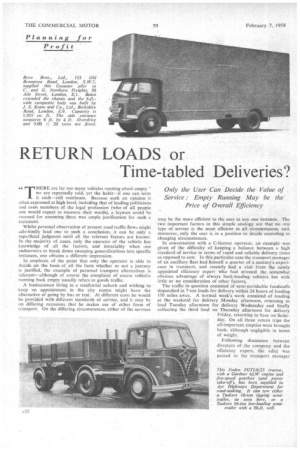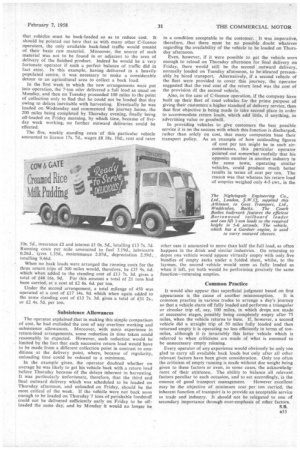RETURN LOADS or Time-tabled Deliveries?
Page 80

Page 87

If you've noticed an error in this article please click here to report it so we can fix it.
44 HERE are far too many vehicles running about empty"
we are repeatedly told; yet the habit—if one can term
it such—still continues. Because such an opinion is often expressed at high level, including that of leading politicians and even members of the legal profession (who of all people one would expect to measure their words), a layman could be excused for assuming there was ample justification for such a statement.
Whilst personal observation of present road traffic flows might admittedly -lead one to such a conclusion, it can be only a superficial judgment until all the relevant factors are known. In the majority of cases, only the operator of the vehicle has knowledge of all the factors, and invariably when one endeavours to break down sweeping generalitations into specific instances, one obtains a different impression.
In emphasis of the point that only the operator is able to decide on the basis of all the facts whether or not a journey is justified, the example of personal transport alternatives is relevant—although of course the complaint of excess vehicles running back empty usually refers to goods traffic.
A businessman living in a residential suburb and wishing to keep an appointment in the city centre might have the alternative of going by bus or taxi. At different costs he would be provided with different standards of service, and it may be on differing occasions that he makes use of either form of transport. On the differing circumstances, either of the services may be the more efficient to the user in any one instance. The two important factors in this simple analogy are that no one type of service is the most efficient in all circumstances, and, moreover, only the user is in a position to decide according to changing circumstances.
In conversation with a C-licence operator, an example was given of the difficulty of keeping a balance between a high standard of service in terms of rapid and reliable delivery times as opposed to cost. In this particular case the transport manager of an ancillary fleet had himself a quarter of a century's experience in transport, and recently had a visit from the newly appointed efficiency expert who had stressed the , somewhat obvious advantage of always back-loading vehicles but with little or no consideration of other factors.
The traffic in question consisted of semi-perishable foodstuffs dispatched in 7-ton loads for delivery within 24 hours of loading 150 miles away. A -normal week's work consisted of loading at the weekend for delivery Monday afternoon, returning to load Tuesday afternoon for delivery Wednesday and finally collecting the third load on Thursday afternoon for delivery Friday, returning to base on Saturday. On all three return trips the all-important empties were brought back, although negligible in terms of weight.
Following discussion between directors of the company and the efficiency expert, the edict was passed to the transport manager that vehicles must be back-loaded so as to reduce cost. It should be pointed out here that as with many other C-licence operators, the only available back-load traffic would consist of their basic raw material. Moreover, the source of such material was not to be found in or adjacent to the area of delivery of the finished product. Indeed he would be a very fortunate operator if such a perfect balance of traffic did in fact exist. In this example, having delivered in a heavily populated centre, it was necessary to make a considerable detour to an agricultural area to collect a back load.
In the first iveek in which the new arrangements were put into operation, the 7-ton oiler delivered a full load as usual on Monday, and then on Tuesday proceeded 100 milesto the point of collection only to find that he could not be loaded that day owing to delays inevitable with harvesting. Eventually he was loaded on Wednesday and commenced the journey home, the 200 miles being completed by Thursday evening, finally being off-loaded on Friday morning, by which time, because of fiveday week working, no further outward deliveries could be effected.
The five, weekly standing costs ' of this particular vehicle amounted to licence 17s. 7d., wages £8 18s. 10d., rent and rates 10s. 5d., insurance £2 and interest £1 Os. 5d., 'totalling £13 7s. 3d. Running costs per mile amounted to fuel 3.I9d., lubricants 0.26d., tyres 1.35d., maintenance 2.07d., depreciation 2.59d totalling 9.46d.
When no back loads were arranged the running costs for the three return trips of 300 miles would, therefore, be £35 9s. 6d. which when added to the standing cost of £13 7s. 3d. gives a total of £48 16s. 9d. For this amount a total of 21 tons had been carried, at a cost of £2 6s. 6d. per ton.
Under the second arrangement, a total mileage of 450 was operated at a cost of £17 14s. 9d. which when again added to the same standing cost of £13 7s. 3d. gives a total of £31 2s., or £2 4s. 5d. per ton.
Subsistence Allowances
The operator explained that in making this simple comparison of cost, he had excluded the cost of any overtime working and subsistence allowances. Moreover, with more experience in return-load arrangements, some reduction in time taken could reasonably be expected. However, such reduction would be limited by the fact that each successive return load would have to be made from a different collection point in contrast to conditions at the delivery point, where, because of regularity, unloading time could be reduced to a minimum.
In the example given, the operator doubted whether on average he was likely to get his vehicle back with a return load before Thursday because of the delays inherent in harvesting. It was particularly unfortunate, therefore, that the third and final outward delivery which was scheduled to be loaded on Thursday afternoon, and unloaded on Friday, should be the most critical of the week. If the vehicle were not back soon enough to be loaded on Thursday 7 tons of perishable foodstuff could not be delivered sufficiently early on Friday to be offloaded the same day, and by Monday it would no longer be
in a condition acceptable to the customer. It was imperative, therefore, that there must be no possible doubt whatever regarding the availability of the vehicle to be loaded on Thursday afternoon.
Even, however, if it were possible to get the vehicle soon enough to reload on Thursday afternoon for final delivery on Friday, there would still be the second outward delivery, normally loaded on Tuesday afternoon, to be cleared presumably by hired transport. Alternatively, if a second vehicle of the fleet were provided to cover this journey, the operator suggested that the real cost of the return load was the cost of the provision of the second vehicle.
Also, in the case of C-licence operation, if the company have built up their fleet of road vehicles for the prime purpose of giving their customers a higher standard of delivery service, then that first objective is being made to take second place in order to accommodate return loads, which add little, if anything, in advertising value or goodwill.
In providing vehicles to give customers the best possible service it is on the success with which this function is discharged.
rather than solely on cost, that many companies base their transport policy. As an example of how misleading figures of cost per ton might be in such circumstances, this particular operator pointed out somewhat ruefully that his opposite number in another industry in the same town, operating similar vehicles, could produce much better results in terms of cost per ton. The reason was that whereas his return load of empties weighed only 4-5 cwt., in the
other case it amounted to more than half the full load, as often happens in the drink and similar industries. On returning to depot one vehicle would appear virtually empty with only. five bundles of empty sacks under a folded sheet, whilst, to the layman, the second vehicle would seem as fully loaded as when it left, yet both would be performing precisely the same function—returning empties.
Common Practice It would also appear that superficial judgment based on first
appearance is the cause of another misconception. It is common practice in various trades to arrange a day's journey so that a vehicle 'starts off fully loaded and performs a triangular or circular trip of, say, 100 miles, in which drops are made at successive stages, possibly being completely empty after 75 miles, when the vehicle returns to base. If, however, a second vehicle did a straight trip of 50 miles fully loaded and then returned empty it is operating no less efficiently in terms of tonmiles, although it is invariably this latter vehicle which is referred to when criticisms are made of what is assumed to be unnecessary empty running.
Every operator of any experience would obviously be only too glad to carry all available back loads but only after all other relevant factors have been given consideration. Only top often the criticism of empty running is made without due weight being given to these factors or even, in some cases, the acknowledgment of their existence. The ability to balance all relevant factors peculiar to each occasion, and to act accordingly, is the
essence of good transport management. However excellent may be the objective of minimum cost per ton carried, the inherent function of transport is to provide an acceptable service to trade and industry. It should not be relegated to one of secondary importance through over-emphasis of other factors.
































































































































